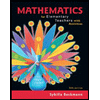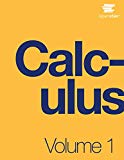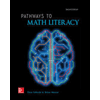1 Infinite Series, Power Series 2 Complex Numbers 3 Linear Algebra 4 Partial Differentitation 5 Multiple Integreals 6 Vector Analysis 7 Fourier Series And Transforms 8 Ordinary Differential Equations 9 Calculus Of Variations 10 Tensor Analysis 11 Special Functions 12 Series Solutions Of Differential Equations; Legendre, Bessel, Hermite, And Laguerre Functions 13 Partial Differential Equations 14 Functions Of A Complex Variable 15 Probability And Statistics expand_more
7.1 Introduction 7.2 Simple Harmonic Motion And Wave Motion; Periodic Functions 7.3 Application Of Fourier Series 7.4 Average Value Of A Function 7.5 Fourier Coefficients 7.6 Dirichlet Conditions 7.7 Complex Form Of Fourier Series 7.8 Other Intervals 7.9 Even And Odd Functions 7.10 An Applications To Sound 7.11 Parseval's Theorem 7.12 Fourier Transforms 7.13 Miscellaneous Problems expand_more
Problem 1P: The functions in Problems 1 to 3 are neither even nor odd. Write each of them as the sum of an even... Problem 2P: The functions in Problems 1 to 3 are neither even nor odd. Write each of them as the sum of an even... Problem 3P: The functions in Problems 1 to 3 are neither even nor odd. Write each of them as the sum of an even... Problem 4P: The functions in Problems 1 to 3 are neither even nor odd. Write each of them as the sum of an even... Problem 5P: Each of the functions in Problems 5 to 12 is given over one period. For each function, sketch... Problem 6P: Each of the functions in Problems 5 to 12 is given over one period. For each function, sketch... Problem 7P: Each of the functions in Problems 5 to 12 is given over one period. For each function, sketch... Problem 8P: Each of the functions in Problems 5 to 12 is given over one period. For each function, sketch... Problem 9P: Each of the functions in Problems 5 to 12 is given over one period. For each function, sketch... Problem 10P: Each of the functions in Problems 5 to 12 is given over one period. For each function, sketch... Problem 11P: Each of the functions in Problems 5 to 12 is given over one period. For each function, sketch... Problem 12P: Each of the functions in Problems 5 to 12 is given over one period. For each function sketch several... Problem 13P: Give algebraic proofs of (9.3). Hint: Write tl=l0+0l, make the change of variable x=t in t0, and use... Problem 14P: Give algebraic proofs that for even and odd functions: (a) even times even = even; odd times odd =... Problem 15P: Given f(x)=x for 0x1, sketch the even function fc of period 2 and the odd function fx of period 2,... Problem 16P: Let f(x)=sin2x,0x. Sketch (or computer plot) the even function fc of period 2, the odd function f,... Problem 17P: In Problems 17 to 22 you are given f(x) on an interval, say 0xb. Sketch several periods of the even... Problem 18P: In Problems 17 to 22 you are given f(x) on an interval, say 0xb. Sketch several periods of the even... Problem 19P: In Problems 17 to 22 you are given f(x) on an interval, say 0xb. Sketch several periods of the even... Problem 20P: In Problems 17 to 22 you are given f(x) on an interval, say 0xb. Sketch several periods of the even... Problem 21P: In Problems 17 to 22 you are given f(x) on an interval, say 0xb. Sketch several periods of the even... Problem 22P: In Problems 17 to 22 you are given f(x) on an interval, say 0xb. Sketch several periods of the even... Problem 23P: If a violin string is plucked (pulled aside and let go), it is possible to find a formula f(x,t) for... Problem 24P: If, in Problem 23, the string is stopped at the center and half of it is plucked, then the function... Problem 25P: Suppose that f(x) and its derivative f(x) are both expanded in Fourier series on (,). Call the... Problem 26P: In Problems 26 and 27, find the indicated Fourier series. Then differentiate your result repeatedly... Problem 27P: In Problems 26 and 27, find the indicated Fourier series. Then differentiate your result repeatedly... format_list_bulleted


 Discrete Mathematics and Its Applications ( 8th I...MathISBN:9781259676512Author:Kenneth H RosenPublisher:McGraw-Hill Education
Discrete Mathematics and Its Applications ( 8th I...MathISBN:9781259676512Author:Kenneth H RosenPublisher:McGraw-Hill Education Mathematics for Elementary Teachers with Activiti...MathISBN:9780134392790Author:Beckmann, SybillaPublisher:PEARSON
Mathematics for Elementary Teachers with Activiti...MathISBN:9780134392790Author:Beckmann, SybillaPublisher:PEARSON
 Thinking Mathematically (7th Edition)MathISBN:9780134683713Author:Robert F. BlitzerPublisher:PEARSON
Thinking Mathematically (7th Edition)MathISBN:9780134683713Author:Robert F. BlitzerPublisher:PEARSON Discrete Mathematics With ApplicationsMathISBN:9781337694193Author:EPP, Susanna S.Publisher:Cengage Learning,
Discrete Mathematics With ApplicationsMathISBN:9781337694193Author:EPP, Susanna S.Publisher:Cengage Learning, Pathways To Math Literacy (looseleaf)MathISBN:9781259985607Author:David Sobecki Professor, Brian A. MercerPublisher:McGraw-Hill Education
Pathways To Math Literacy (looseleaf)MathISBN:9781259985607Author:David Sobecki Professor, Brian A. MercerPublisher:McGraw-Hill Education




